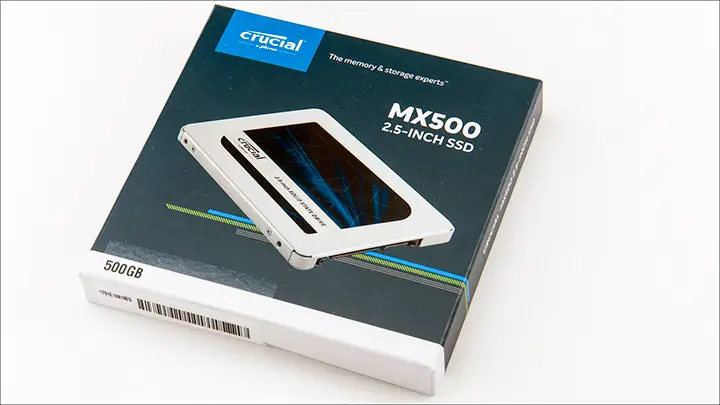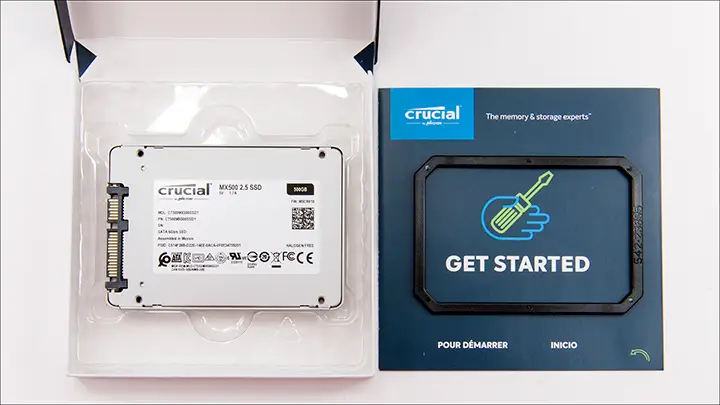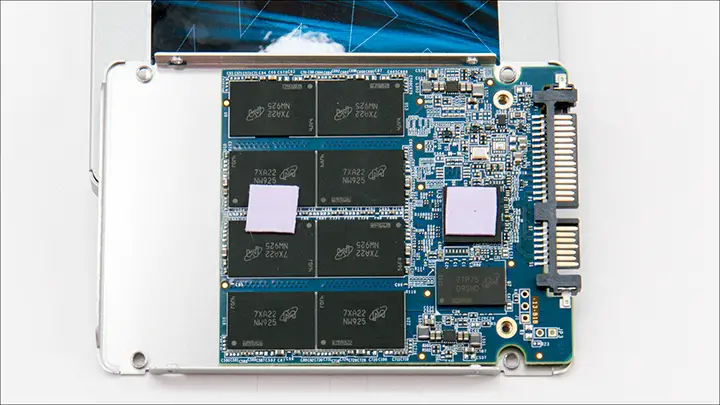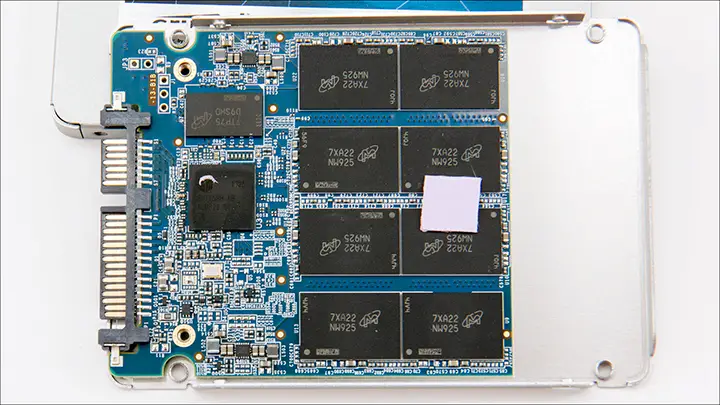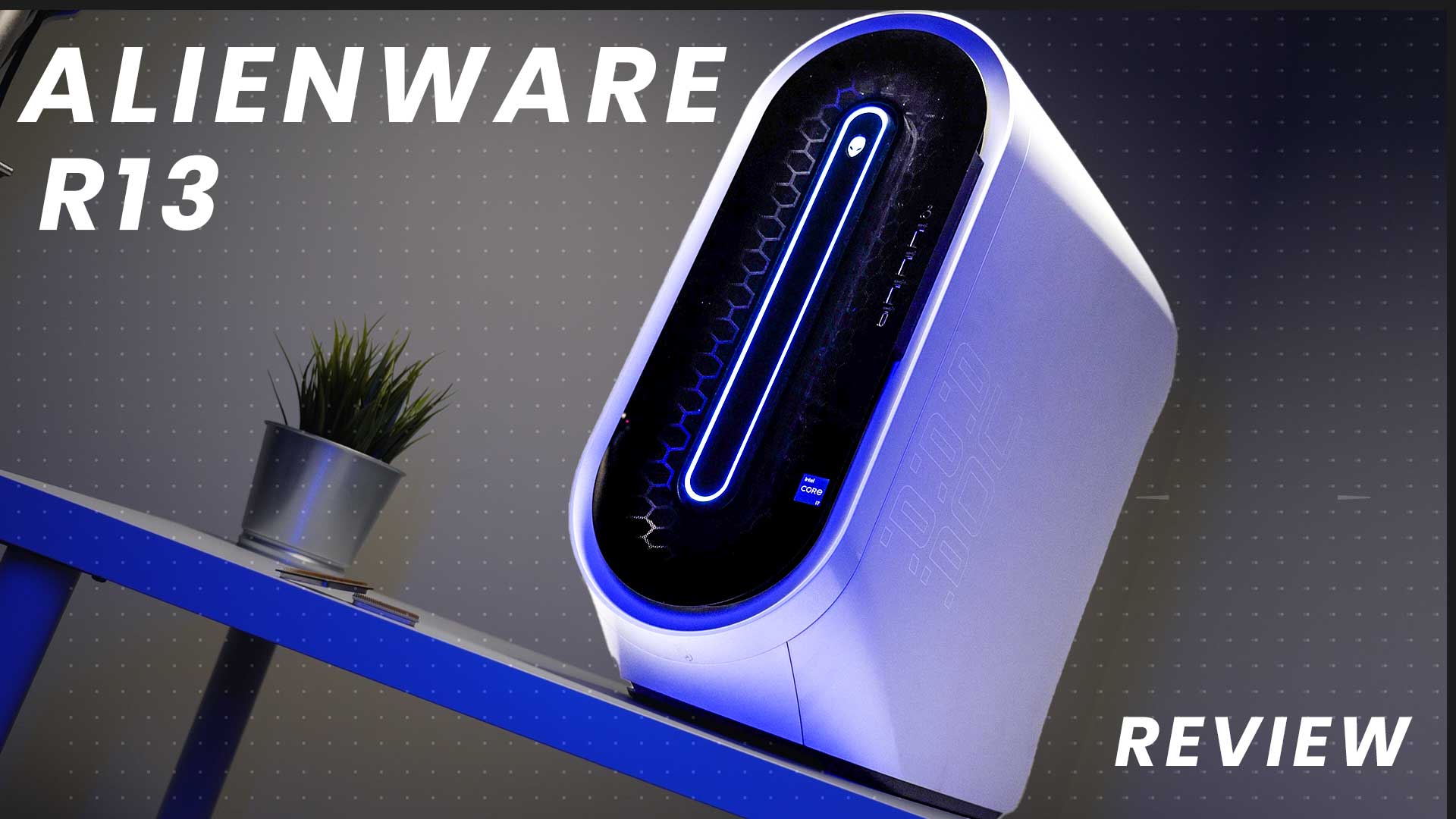Let’s start with what has not changed from the previous MX300 series. As with the MX300, the MX500 series comes in a ‘classic Crucial’ shipping container. That means conservative looks and styling but plenty of information on the back of the box to make deciding on one model over another down right simple. Just be careful as with the exception of a small sticker all MX500 shipping containers are the same. As such you may get a surprise at checkout when you think you picked up a 500GB drive but in reality it was a 1TB or 2TB model – so pay attention to the capacity listed on the front… or use it as a good excuse to justify to your significant other why you came away from your local bricks and mortar with a much more expensive drive.
Next the accessories are the same. Expect to find a serial number for a simplified version of Acronis True Image, and a 2.5mm adapter that allows the MX500’s 7mm formfactor to work in older systems that need a 9.5mm form-factor drive.
The chassis is also classic Crucial in that it is an all metal affair that is robust and works eons better than plastic that some similarly priced models from the competition still use.
There is also one more point of commonality. To see this last similar design choice, you will have to crack open the chassis and peak inside. As with the MX300 the MX500 makes use of a smaller ‘3/4 length’ PCB that can house upto 8 NAND dies on one side and up to another 8 on the other side. The PCB itself also allows for up to two external RAM ICs and a single controller. As with the smaller MX300 capacity options the MX500 500GB comes equipped with only a moderate amount (256MB) of onboard RAM. Though 256MB is half of what the smaller MX300 required the controller – more on this in a moment – is much more capable and does not need to push as much data to its RAM buffer. As such is a moot point on the difference from one gen to the next.
That is about all that Crucial has carried over. The most obvious change is the NAND. As mentioned in the previous page this is brand new second generation TLC 3D NAND. The biggest change is that each ‘block’ (or what used to be called a ‘layer’ in 2D NAND days) now consists of 64 layers of NAND cells instead of 32. This improvement however does not mean increased density. Instead Crucial has used more layers to hit a lower total capacity. Specifically, the second generation is 256Gb(32GB) TLC NAND not 384Gb(48GB). This reduction in density means the cells are more robust and less likely to fail when compared to the previous TLC NAND – especially when each of these ‘blocks’ are stacked. Equally important is that they will also run cooler than gen 1 TLC, and the cooler the NAND the less likely thermal throttling will occur.
This change in density actually means a few nice improvements have been made at the channel level. With the last generation MX300 the number of NAND per channel was usually lopsided with some channels have more than other channels which resulted in sometimes… ‘odd’ (or unexpected) performance results. With the MX500 500GB we have eight dual-die (i.e. 128 layers tall) ICs and as such have an NAND Interleaving (NAND per Channel) of 4/4/4/4. This is also why the odd ball sizes of 275/525/750/1050/2050 have been replaced with much more typical 250/500/1000/2000.
Also in a very nice move, is that the amount of over-provisioning(OP) has been greatly improved. The MX300 525GB only had a mediocre amount of OP (~3GB) whereas this 500GB has a very nice ~12GB. This improved NAND interleaving and better over-provisioning on the smaller capacities should translate into better performance but this is only the start of the changes. Crucial did signal their intentions to move away from Marvell when they released the SMI 2258H based BX300 and this new trend continues with the MX500. Simply put this is the first ever M – let alone MX – to not be Marvell based. Instead we see the potent SMI 2258 controller making an encore. This time paired with second gen TLC 3D NAND instead of first gen MLC 3D NAND like it was in the BX300.
In simplest terms this move is great news for consumers as Marvell was just not keeping up with the industry and SMI did surpass them in performance and performance consistency metrics quite some time ago. More importantly Crucial’s firmware team has now had plenty of time to fine tune firmware for this controller to the specific quirks of Microns 3D NAND. As such we fully expect the MX500 to – relatively speaking – blow the doors off a MX300 in real world performance.
Unfortunately the downside to changing the controller is the amount of onboard capacitors has been slashed. This however does not mean data is any less secure in the event of an unexpected power loss. SMI uses a unique firmware based data loss prevention mechanism and the NAND is faster and more power efficient than ever before. So while this looks like a down grade, the rows and rows of super-capacitors was simply not needed. It also means that the M.2 version will be just as protected as the 2.5″ form-factor models – and that is indeed great news.
Overall we think that Crucial has indeed made great strides in improving their MX series but it will not be without controversy. Though if the performance is good enough we doubt any one will care about the TLC vs MLC debate. Instead the performance, warranty and price will be just too persuasive to care about these ‘issues’. Continue reading to see if that is indeed the case.
